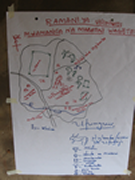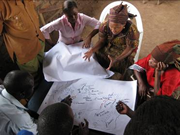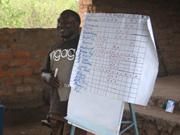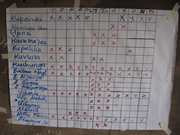Project of the Month. I’m very lucky because every week I receive project progress reports from people from all over the world. I get to learn the intricate details about people’s lives living in drought conditions in deserts, I get to learn about people living in flood conditions in river deltas, and I get to learn about people’s lives in conflict situations.
To download these reports and learn about the participatory process please go to the bottom of the page.
Collecting local knowledge is very participatory and very interesting. Working with a series of vulnerability and capacity analysis tools, Chris and his partner Philip worked with the community to develop a list of local resources, hazard maps, a seasonal calendar, a historical timeline and a discussion on current local coping strategies and aspired strategies. Here are a few examples of the workshop results:
Resources:
- Water wells
- Forest (bush)
- Seasonal river
- Primary school
- Land for crop cultivation
- Land for grazing
Hazards in their Community:
- Floods
- Drought
- Malaria spread
- Hunger (as a result of droughts)
- Lack of health services within the community
- Tuberculosis
Seasonal Calendar:
- Sowing seeds
- Farm preparation
- Building houses
- Selling crops
- Weeding
- Crop harvesting
- Grazing livestock
Drought and Flood
The facilitator asked group members to rank the vulnerability of each identified resource from each of the identified hazard.rought and flood ranked as the highest hazards to livelihood resources. See the livelihood/hazard results matrix here.
The information that was gathered during this process, and the way that the information was collected in the participatory fashion, will do two things at once. This Tanzania and team will be able to improve their project design with new and more complete information—and most importantly with community feedback—and the community will continue the process of developing ownership in their project. Being able to provide knowledge, feedback, and project direction continues to reinforce for the community that this is their project—not an outsider’s.
To see the project reports about the workshop and about assimilating the information (not to mention some of the best photos I’ve seen yet!) simply follow these links:
Enns Gheorghe A5
Philip Chiwanga VCA Workshop
To learn more about the process:
OL 343 Adapting to Climate Change: The Community Focus
CARE: Climate Vulnerability and Capacity Analysis
Learn how to develop a community centered, impact oriented project.




